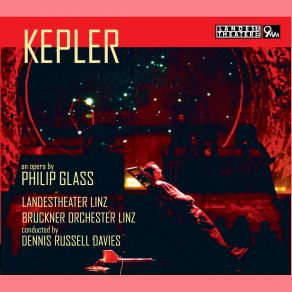Philip Glass: Kepler
Download links and information about Philip Glass: Kepler by Bruckner Orchestra Linz, Dennis Russell Davies, Chorus Of The Landestheater Linz, Landestheater Linz. This album was released in 2010 and it belongs to Theatre/Soundtrack, Opera genres. It contains 15 tracks with total duration of 01:53:56 minutes.

|
|
|---|---|
| Artist: | Bruckner Orchestra Linz, Dennis Russell Davies, Chorus Of The Landestheater Linz, Landestheater Linz |
| Release date: | 2010 |
| Genre: | Theatre/Soundtrack, Opera |
| Tracks: | 15 |
| Duration: | 01:53:56 |
| Buy it NOW at: | |
| Buy on iTunes $19.99 | |
Tracks
[Edit]| No. | Title | Length |
|---|---|---|
| 1. | Kepler: Prologue | 6:45 |
| 2. | Kepler, Act I: I. Questions | 5:35 |
| 3. | Kepler, Act I: II.Polyeder | 8:36 |
| 4. | Kepler, Act I: III. Genesis | 6:16 |
| 5. | Kepler, Act I: IV. Gryphius 1: Upon the Night | 9:50 |
| 6. | Kepler, Act I: V. Physica Coelestis | 7:24 |
| 7. | Kepler, Act I: VI. Gryphius 2 | 8:29 |
| 8. | Kepler, Act I: VII. Questions 2 | 6:52 |
| 9. | Kepler, Act I: Gryphius 3: Eyes. Optical Paradox | 6:26 |
| 10. | Kepler, Act II: I. On Astrology | 9:01 |
| 11. | Kepler, Act II: II. Gryphius 4: To the Stars | 10:34 |
| 12. | Kepler, Act II: III. Hypotheses | 9:54 |
| 13. | Kepler, Act II: IV. Gryphius 5: Tears of the Fatherland | 6:27 |
| 14. | Kepler, Act II: V. Ephemerides | 5:38 |
| 15. | Kepler: Epilogue | 6:09 |
Details
[Edit]The 2013 film Visitors reunited Philip Glass with the American experimental filmmaker Godfrey Reggio, the director of Koyaanisqatsi and several successor films that not only spawned some of Glass' most famous scores but pushed his music in a new direction. The kinetic images of Koyaanisqatsi, symbolic of the out-of-control complexity of civilization, stimulated a new intensity in Glass' compositions, manifesting itself in a wider tonal palette and a new textural variety that soon spread itself across his more abstract output as well. Those looking for another installment in the Koyaanisqatsi series may be disappointed, for Reggio's film is quite different from its predecessors: in place of the speeded-up time-lapse photography of the earlier films is a series of just 74 long takes, many of them almost static. They show a gorilla, faces, the moon. Glass' response to this comes closer to his earlier minimalist style than most of his other scores from after the turn of the century. He boils the entire set of images down to six cuts, which moreover are cyclical: the final track repeats the opening material. The long open-octave sonorities here may take listeners back to the pioneering works of the minimalist movement, and while the pace picks up after that, Glass moves more in the direction of amplifying space than exploring the quasi-tonal relationships that have characterized his more recent work. The music is dominated by the strings, and the little-known Bruckner Orchester Linz under Dennis Russell Davies does well with what must have been an unfamiliar sound for them; perhaps their Brucknerian background prepared them for the large arcs of Glass' orchestral music. Whether there is more to be found in the old language is a question for time to determine, but Glass buffs may well be intrigued by this new wrinkle in his oeuvre. As usual with the Glass-associated Orange Mountain Music label, you get little documentation but clear sonics.